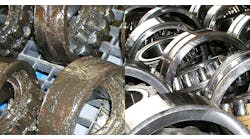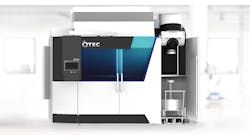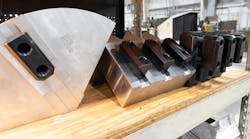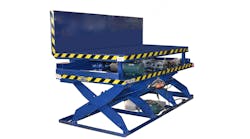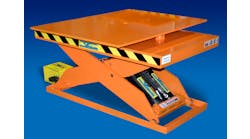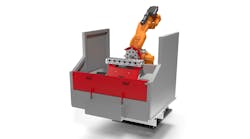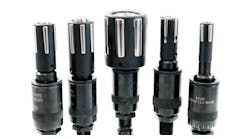Gears are, by definition, precision parts: there is precision in the design of a gear, precision in the forging of gears, and precision in the performance of gears in the systems they drive. Obviously, there must be some precision in the intermediate steps, like the finishing and deburring that happens after the forming of the part and before it’s delivery.
Engineering and manufacturing technology specialist Renishaw Inc. recently helped a power-transmission gear manufacturer and its finishing technology supplier to solve problems occurring during the finishing and deburring stage.
Finnish gear and gearbox manufacturer Katsa Oy commissioned Flexmill Oy to design and build a robotized finishing cell for machining ranging in size from 2 in. to 5 ft. in diameter. The turnkey cell incorporates Renishaw RMP60 probes mounted on custom-designed tool holders, which an ABB robot uses to collect critical part-location data before finishing and deburring operations begin.
Deburring gears manually using grinding wheels can be unreliable, resulting in inconsistent finishes across parts in the same batch. Machine operators have to be highly skilled to achieve the high-quality and consistent finish, and even in such case there will be variations from one operator to another.
In addition, manual deburring is a dirty and hazardous job, which few of the Katsa operators were eager to undertake. So, finishing and deburring operations became a manufacturing bottleneck, with a cumulative effect often causing significant delays.
Sami Niemelainen, quality and development manager at Katsa, explained: “The reason we invested in the robotic cell was not to make the job faster; the reasons were better quality and consistency. Also, the task of deburring is now cleaner and safer for our machine-shop operators, and that’s very important.
To automate gear deburring, Flexmill built a cell incorporating an ABB robot, a Renishaw RMP60 probe, and a twin pallet system that allows one gear to be machined while another is loaded.
“With any operator willing to take on deburring using the Flexmill robotized system with Renishaw’s RMP60 probe, delays have been eliminated and lead time is more consistent and predictable,” Niemelainen reported.
To ensure all excess material on the machined gears is removed automatically by the deburring process, the Flexmill software requires the exact geometrical parameters of the gears and the gear teeth. Some of these parameters are known and available for each of the many different gears made by Katsa. But, those parameters that are not known can be measured using the Renishaw RMP60 probe with radio signal transmission. The ABB robot uses the probe to locate parts during set-up, with the resulting positional data used by the control software to generate a complete, automated deburring cycle. No manual programming is required. Once machined, the RMP60 probe is used in the post-process inspection to confirm finished dimensions.
The RMP60 probe is well suited to this application due to its solid construction and reliable, frequency-hopping spread spectrum (FHSS) protocol. This means that communication between the probe and its receiver remains stable even if, for example, ‘line-of-sight’ is lost or if another radio source enters the environment.
“The Renishaw RMP60 probe has been working very well and it makes it possible for the Flexmill software to generate a full deburring program for every one of the gears we manufacture,” Niemelainen concluded. “We only need to give some parameters to the control and the robot will use the Renishaw probe to create the program automatically. The result is that quality is always the same, each and every time we deburr a gear.”


